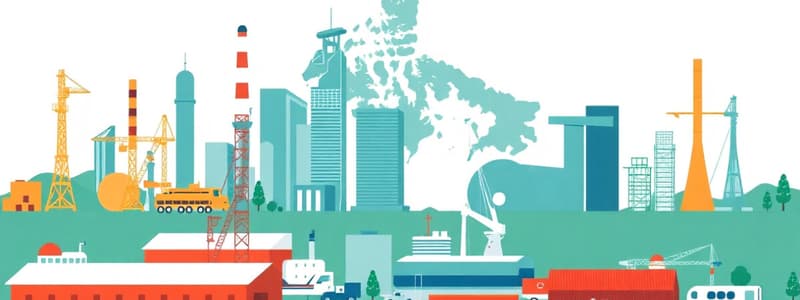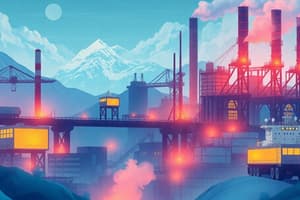Podcast
Questions and Answers
Which of the following is an example of a basic industry?
Which of the following is an example of a basic industry?
- Transportation service
- Retail store
- Farming (correct)
- A hairdresser
The tertiary sector primarily focuses on the manufacturing of goods.
The tertiary sector primarily focuses on the manufacturing of goods.
False (B)
Name one primary industry in Canada.
Name one primary industry in Canada.
Agriculture
In the three-sector theory, economic activities shift from the primary to the secondary and finally to the _______ sector.
In the three-sector theory, economic activities shift from the primary to the secondary and finally to the _______ sector.
Match the following economic terms with their definitions:
Match the following economic terms with their definitions:
Which industries use natural resources to produce finished products?
Which industries use natural resources to produce finished products?
In Canada, the service industry tends to earn more money than the goods-producing industries.
In Canada, the service industry tends to earn more money than the goods-producing industries.
What is a trade surplus?
What is a trade surplus?
What was the main contributor to Canada's trade deficit in 2009?
What was the main contributor to Canada's trade deficit in 2009?
The USMCA replaced the North American Free Trade Agreement (NAFTA).
The USMCA replaced the North American Free Trade Agreement (NAFTA).
What percentage did metals and alloys exports decrease due to lower demand?
What percentage did metals and alloys exports decrease due to lower demand?
Canada's biggest contributor to trade surplus or deficit is the __________ sector.
Canada's biggest contributor to trade surplus or deficit is the __________ sector.
Match the following aspects of USMCA with their descriptions:
Match the following aspects of USMCA with their descriptions:
What might happen to Mexico's wages as a result of competition with the US under USMCA?
What might happen to Mexico's wages as a result of competition with the US under USMCA?
Canada's dependence on the US economy is a reason to worry about trade deficits.
Canada's dependence on the US economy is a reason to worry about trade deficits.
The trade agreement signed in 1988 that initiated free trade with the US was called __________.
The trade agreement signed in 1988 that initiated free trade with the US was called __________.
What is USMCA primarily designed to ensure?
What is USMCA primarily designed to ensure?
The Cod Moratorium imposed in 1992 allowed fishing for cod to continue.
The Cod Moratorium imposed in 1992 allowed fishing for cod to continue.
What is one of the primary reasons for the collapse of the Cod fisheries in Canada?
What is one of the primary reasons for the collapse of the Cod fisheries in Canada?
What is a major cause of overfishing?
What is a major cause of overfishing?
______ are benefits applied to products made in the same country, which can include tax reductions.
______ are benefits applied to products made in the same country, which can include tax reductions.
Match the following types of fishing with their characteristics:
Match the following types of fishing with their characteristics:
Illegal fishing contributes to the tragedy of the commons.
Illegal fishing contributes to the tragedy of the commons.
What was the GDP calculated in the example given?
What was the GDP calculated in the example given?
Which type of fish is categorized as ground fish?
Which type of fish is categorized as ground fish?
Free trade policies impose high tariffs on imported goods.
Free trade policies impose high tariffs on imported goods.
The basic industry is crucial for the local economy because it is the base of the __________ economy.
The basic industry is crucial for the local economy because it is the base of the __________ economy.
What is overfishing?
What is overfishing?
What is the primary sector of the economy concerned with?
What is the primary sector of the economy concerned with?
Match the following sectors of the economy with their descriptions:
Match the following sectors of the economy with their descriptions:
Tertiary industries are less profitable than primary industries.
Tertiary industries are less profitable than primary industries.
What significant change happened to China and India between 1990-2000?
What significant change happened to China and India between 1990-2000?
NAFTA was first established in 1993 and later renegotiated in 2018 as USMCA.
NAFTA was first established in 1993 and later renegotiated in 2018 as USMCA.
What caused Canada to experience a trade deficit in 2009?
What caused Canada to experience a trade deficit in 2009?
Canada's main trade partner is the __________.
Canada's main trade partner is the __________.
Match the following terms with their definitions:
Match the following terms with their definitions:
Which natural resource significantly impacted Canada's economy in 2009?
Which natural resource significantly impacted Canada's economy in 2009?
Exports are unimportant for the Canadian economy.
Exports are unimportant for the Canadian economy.
What role do nations trade natural resources?
What role do nations trade natural resources?
Flashcards
Primary Industry
Primary Industry
Harvesting natural resources.
Secondary Industry
Secondary Industry
Manufacturing or processing raw materials into products.
Tertiary Industry
Tertiary Industry
Providing services, not creating goods.
Trade Surplus
Trade Surplus
Signup and view all the flashcards
Trade Deficit
Trade Deficit
Signup and view all the flashcards
Import
Import
Signup and view all the flashcards
Export
Export
Signup and view all the flashcards
Basic Industries
Basic Industries
Signup and view all the flashcards
Canada's Trade Deficit
Canada's Trade Deficit
Signup and view all the flashcards
Impact of Oil Prices on Trade
Impact of Oil Prices on Trade
Signup and view all the flashcards
USMCA Key Goals
USMCA Key Goals
Signup and view all the flashcards
Consequences of Trade Dependence
Consequences of Trade Dependence
Signup and view all the flashcards
USMCA Implications for Jobs
USMCA Implications for Jobs
Signup and view all the flashcards
Alternatives to US Dependence
Alternatives to US Dependence
Signup and view all the flashcards
NAFTA
NAFTA
Signup and view all the flashcards
Trade and Consumer Benefits of Free Trade
Trade and Consumer Benefits of Free Trade
Signup and view all the flashcards
USMCA
USMCA
Signup and view all the flashcards
Why do nations trade?
Why do nations trade?
Signup and view all the flashcards
Balance of trade
Balance of trade
Signup and view all the flashcards
2009 Trade Deficit in Canada
2009 Trade Deficit in Canada
Signup and view all the flashcards
Importance of Exports to Canada
Importance of Exports to Canada
Signup and view all the flashcards
Tariff
Tariff
Signup and view all the flashcards
Subsidy
Subsidy
Signup and view all the flashcards
Free Trade
Free Trade
Signup and view all the flashcards
Protectionism
Protectionism
Signup and view all the flashcards
Cod Moratorium
Cod Moratorium
Signup and view all the flashcards
Overfishing
Overfishing
Signup and view all the flashcards
Longlining
Longlining
Signup and view all the flashcards
Overfishing Cause
Overfishing Cause
Signup and view all the flashcards
Illegal Fishing
Illegal Fishing
Signup and view all the flashcards
Non-Basic Industry
Non-Basic Industry
Signup and view all the flashcards
GDP (Gross Domestic Product)
GDP (Gross Domestic Product)
Signup and view all the flashcards
GDP per Capita
GDP per Capita
Signup and view all the flashcards
Industrial Revolution
Industrial Revolution
Signup and view all the flashcards
Sectors of the Economy
Sectors of the Economy
Signup and view all the flashcards
Study Notes
Basic Industries
- Basic industries supply raw materials or products
- Examples include agriculture and oil
Non-Basic Industries
- The money in these industries circulates within the community
- Examples include jobs at a hardware store or hairdresser
Primary Industries
- These industries harvest natural resources
- Examples include farming, coal mining, and forestry
Secondary Industries
- These industries manufacture or process raw materials
- An example is turning farm-produced leather into a jacket
Tertiary Industries
- These industries sell services
- An example is a trucking company transporting goods
Economic Cycle
- Raw materials are extracted from the primary sector
- These materials are processed in the secondary sector
- Products from the secondary sector (and primary sector) are sold by the tertiary sector
- The economy goes in a continuous loop
Primary Industries in Canada
- Agriculture
- Fisheries
- Forestry
- Mining
- Oil and Gas
Secondary Industries in Canada
- Manufacturing (e.g., clothing)
- Construction (e.g., buildings)
- Utilities (e.g., electricity)
Economic Cycle Diagram
- Shows how raw materials from the primary sector flow into the secondary sector to be made into something
- Then the tertiary sector sells them to consumers
Three-Sector Theory
- The economy progresses from primary to secondary and finally to tertiary industries to become more advanced
- The primary sector is more basic, and the tertiary sector generates more money than the other two.
Canada's State of Trade (2009)
- Canada experienced its first trade deficit since 1975
- The energy sector, especially oil, is a major source of trade surplus or deficit for
- The price of oil fell dramatically
- This significantly impacted Canada's exports
USMCA
- A trade agreement between the US, Mexico, and Canada
- Replaces NAFTA
- It aims to streamline trade and investment
- Includes stricter rules on where products are made
- Provides stronger protections for workers' rights and wages
- Includes new rules for online trade
- Includes more environmentally friendly regulations
Review Questions
- Explain the benefits of Trade: Nations trade for a variety of reasons, including access to goods and services they don't produce themselves, lower prices and to maintain balance of trade.
- Define Balance of Trade: The difference between the total value of a country's exports and imports. A trade surplus occurs when exports exceed imports, and a trade deficit occurs when imports exceed exports.
- Describe the History of Canada's Balance of Trade and Occurrences for the 2009 Trade Deficit: Canada traditionally had a trade surplus due to its natural resources (like oil) but experienced a 2009 trade deficit due to a drop in the oil price.
- Explain the Importance of Exports to the Canadian Economy: Exports are vital because they provide revenue to sustain imports, create jobs, allow the economy to function, and provide a competitive international market for Canadian goods
- Identify Canada's Main Trade Partners: One of the biggest trading partners (and a source of imports for Canada) are the Unites States
Atlantic Fisheries
- Fishing is a renewable resource
- Canada has commercial fisheries along the Atlantic and Pacific coasts, Great Lakes.
- Common fish types: Ground, Pelagic, and Shellfish (cod, haddock, tuna, mackerel, clams, oysters, etc.)
- Regulations, improved techniques and management help keep fisheries healthy
Cod Moratorium
- 1992, a temporary ban on fishing for cod in the Atlantic
- Put 30,000 people out of work
- Cost the Canadian economy significantly
- The Cod population has not fully recovered
Overfishing
- Catching more fish than can be replaced naturally
- Can cause depletion of fish populations
- Leads to damage of marine habitats and ecosystems
Illegal Fishing
- Illegal fishing negatively impacts the economy and marine life
- Often results in overfishing or endangered species.
Business Industries
- Basic industries need to support non basic industries for an economy to function properly
- Non basic industries use products and services from the basic industries and create further revenue
- A local economy is dependent on these two types of industries working together
GDP
- A country's total output of goods and services
- GDP goes up as imports increase
Studying That Suits You
Use AI to generate personalized quizzes and flashcards to suit your learning preferences.




